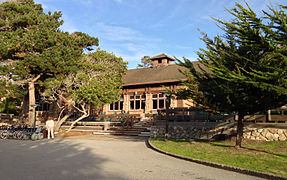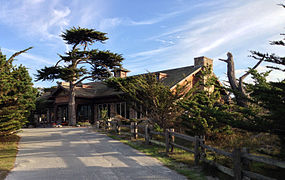Asilomar Conference Grounds
Asilomar Conference Grounds | |
 Merrill Hall, Asilomar | |
| Lua error in Module:Location_map at line 526: Unable to find the specified location map definition: "Module:Location map/data/Monterey Peninsula" does not exist. | |
| Location | Asilomar Blvd., Pacific Grove, California |
|---|---|
| Area | 9 acres (3.6 ha) |
| Built | 1913 |
| Architect | Julia Morgan |
| Architectural style | Arts and Crafts Movement and American craftsman Bungalows |
| NRHP reference No. | 87000823[1] |
| Significant dates | |
| Added to NRHP | February 27, 1987[1] |
| Designated NHL | February 27, 1987[2] |
Asilomar Conference Grounds is a conference center built for the Young Women's Christian Association (YWCA). It is located east of what was known as Moss Beach on the western tip of the Monterey Peninsula in Pacific Grove, California. Between 1913 and 1929 architect Julia Morgan designed and built 16 of the buildings on the property, of which 11 are still standing.[3] In 1956 it became part of the State Division of Beaches and Parks of California's Department of Natural Resources, and Moss Beach was renamed Asilomar State Beach. Asilomar is a derivation of the Spanish phrase asilo al mar, meaning asylum or refuge by the sea.[4]
History
The annual conference of the YWCA of the Pacific Coast had been held at the Capitola, California hotel through 1911. Probably because they had outgrown the space, and because the YWCA had a goal of purchasing grounds, Phoebe Apperson Hearst hosted the 1912 conference at her Hacienda in Pleasanton, California, with all proceeds of that year's conference going toward the purchase of a permanent home. A resulting YWCA committee persuaded the Pacific Improvement Company of Pacific Grove, California to deed 30 acres (120,000 m2) to the YWCA in 1912. In early 1913 the YWCA announced that Julia Morgan, already at work on the Oakland YWCA building, would design the campgrounds. Construction began in the spring of 1913 and in August 1913 the Social Hall and the lodging Longhouses opened with nearly 300 girls in attendance. Merrill Hall, the last of Morgan's designs for Asilomar, was dedicated in 1928.
Several other prominent California women including Ellen Browning Scripps, Mrs. Warren Olney, Jr. and Mary Sroufe Merrill were involved in the creation of the retreat.[5]
The winning entry in the naming contest was by Helen Salisbury, a Stanford student. Her entry created a portmanteau from two Spanish words: Asilo and Mar.
Asilomar was declared a National Historic Landmark in 1987 for its role in women's recreation, the development of the YWCA, and the resort nature of nearby Monterey, California.[6][7][8]
Today
The property is officially named "Asilomar State Beach and Conference Grounds", and is owned by California State Parks. It is currently used primarily as a conference center for hire but is also open to individual lodging guests and is frequently used for family reunions and other social events. The grounds are open to the public. From 1956 until 1994 several non-profit corporations managed the conference grounds in cooperation with California State Parks. Delaware North Companies Parks and Resorts operated the park from 1997-2007 under a concessionaire agreement.[9] Aramark won a new 20-year operating contract in January 2009 and began operations there in September of that year.
To preserve the rustic atmosphere of the resort, there are no telephones or televisions in any of the rooms. However, Wi-Fi has recently been installed throughout the property.
In October, 2012 construction began to improve Asilomar's accessibility under Americans with Disabilities Guidelines. This includes replacement of several old, worn, and rugged asphalt pathways and the construction of new paths made of brick pavers. Construction work will continue into 2014 and will include modifications to improve interior access to several rooms as well as the exterior improvements.
Notable conferences
- 1975 Asilomar conference on recombinant DNA
- 2010 Asilomar international conference on climate intervention technologies
- 1969–2012 West Coast Number Theory (mostly odd years)
In popular culture
Wayne Dyer's movie, The Shift (2009) was shot at Asilomar State Beach and at the Asilomar Conference Grounds.[10][11]
References
- ^ a b "National Register Information System". National Register of Historic Places. National Park Service. July 9, 2010.
- ^ "Asilomar Conference Grounds". National Historic Landmark summary listing. National Park Service. Retrieved 2008-02-18.
- ^ Julia Morgans influence
- ^ Robinson, Judith (1991). The Hearsts: an American dynasty. University of Delaware Press. p. 370. ISBN 0-87413-383-1.
- ^ Asilomar history
- ^ "Asilomar Conference Grounds". National Historic Landmarks Quioklinks. National Park Service. Retrieved 19 March 2012.
- ^ Charleton, James P. (September 27, 1984). "Asilomar Conference Grounds" (pdf). National Register of Historic Places - Inventory Nomination Form. National Park Service. Retrieved 19 May 2012.
- ^ "Asilomar Conference Grounds" (pdf). Photographs. National Park Service. Retrieved 19 May 2012.
- ^ Asilomar State Beach and Conference Grounds: Asilomar Today
- ^ Ambition To Meaning
- ^ The Movie
External links
- Buildings and structures on the National Register of Historic Places in California
- YMCA buildings in the United States
- National Historic Landmarks in California
- History of Monterey County, California
- Buildings and structures in Monterey County, California
- Visitor attractions in Monterey County, California
- Infrastructure completed in 1913
- Arts and Crafts architecture in California
- American Craftsman architecture in California
- Pacific Grove, California
- 1913 establishments in California
- National Register of Historic Places in Monterey County, California








